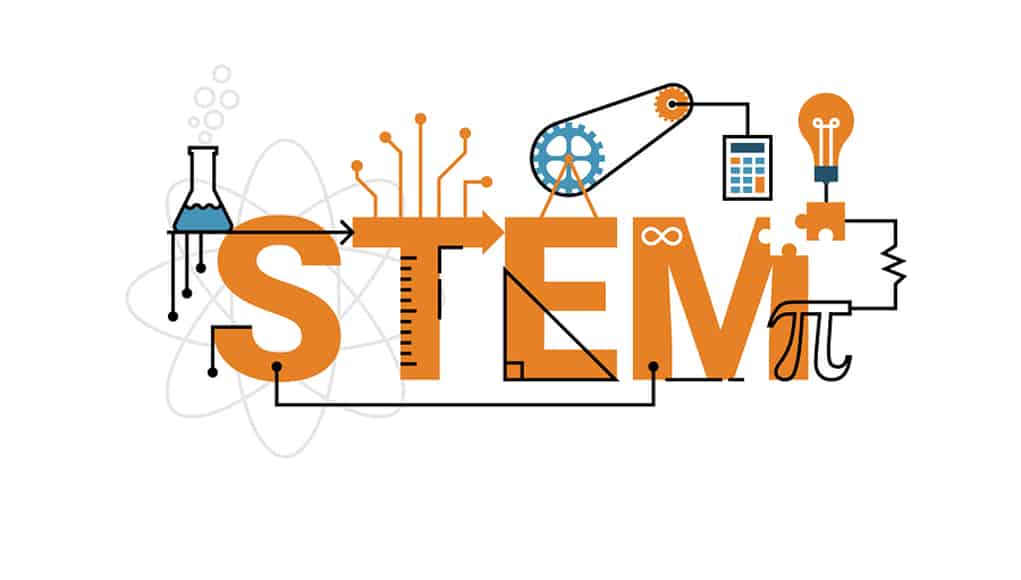12 Ways to Start Teaching STEM in Your School

By Tom Vander Ark and Mary Ryerse
Want more STEM experiences for your students but don’t know where to start? Want to infuse art into science and boost STEAM experiences?
Before exploring how to do STEM, let’s define what it is. Everybody teaches science and math—STEM adds technology and engineering to the equation; STEAM adds art. Common elements of quality STEM learning include:
- Design-focus: using design tools and techniques to attack big problems or opportunity (challenge-based, problem-based learning).
- Active application: applying knowledge and skills to real-world situations and constructing or prototyping solutions to challenges (maker, project-based learning).
- Integration: real world problems aren’t limited to a discipline—solutions almost always draw from many fields.
The following are 12 tips for learning about STEM (and STEAM) experiences and implementing them in your school.
1. Visit Schools. Visiting schools is the best form of professional learning, and especially it is especially so for STEM learning, which is likely to be more active and integrated than traditional pedagogy. A couple schools worth seeing include (with more featured in subsequent points, as well):
- Reynoldsburg Ohio (Columbus) has a K-12 STEM feeder pattern worth seeing, and so is Metro Early College on the OSU campus.
- The 200 schools in the New Tech Network feature integrated project-based learning.
- The 46 Harmony schools (TX & DC) feature personalized project-based STEM learning.
- iDEA and SAMI are both part of Tacoma Public Schools. The Science and Math Institute meets at the Point Defiance Zoo and the Industrial Design Engineering and Art School (iDEA) is new to TPS this year. Check out this short video of our visit:
2. Go on Field Trips. A longstanding and valuable tradition are STEM field trips to science museums, manufacturing facility, energy production facilities and transportation hubs. Jay Greene’s research and podcast speak to the value of field trips. The Museum of Science in Boston (and many other major cities’) provides field trip guides, activity sheets, educator guides, projects and more.
3. Build in Maker Time. In addition to STEM integration into core curriculum, setting aside dedicated maker time provides an ideal entry point for STEM experiences. When we are intentional about finding time to let kids make stuff, it leads to authentic engagement around STEM topics. The possibilities of “when” are numerous—between semesters/trimesters, after school time, summer school, community education or even at a parent-student event. Imagination Foundation, hosts of the Global Cardboard Challenge, are great advocates for maker time.
4. Develop a Makerspace. Maker teacher Lindsey Own has a great 20 blog series on developing a makerspace. The theory is that if you build it, they will come—as evidenced by Lindsey’s many ideas.
In addition to the possibilities for makerspaces within classrooms and schools, many libraries, museums and community centers have started creating makerspaces. For example, the St. Paul Public Library’s central branch offers a hands-on work space with a 3D printer, a laser engraver, a sewing machine, a recording studio and other tools for those with an urge to create.

5. Install an Engineering Curriculum. A fully developed STEM curriculum and training process can be found in the widely used Project Lead the Way program. PLTW offers its Launch curriculum in elementary school, Gateway in middle school, then multiple articulated disciplines where kids can earn college credit in high school towards biomedical science, computer science and engineering. A high school student describes how his PLTW experiences—ranging from VEX Robotics, RobotC, drones, and coding—have provided engaging content and real-world experiences.
6. Practice Project-Based Learning (PBL). With an ever-increasing focus on the importance of PBL, the STEM fields are a natural place for PBL best practices.
- Harmony Public Schools, a Texas network of STEM schools, personalizes learning and emphasiszes STEM through frequent demonstrations of learning. The interdisciplinary model is called Students on Stage (STEM SOS). The online Harmony PBL Showcase designed to promote and share exemplary student work that can serve as valuable learning and teaching tools for students, parents, teachers and other educators. Three STEM-focused project infographics of the hundreds currently available online are shown below.

- Tony Donen, principal of STEM School Chattanooga, writes about how to take PBL and STEM one step at a time.
- Buck Institute for Education (BIE) has great resources for project-based learning and project-based teaching. For more on how they are advocating for high-quality PBL, see What We are Doing to Ensure High Quality PBL for All.
- For more on PBL check out the “Project-Based World” blog series, visit the PBL campaign page and join in the conversation on social media using #ProjectBased.

7. Place-Based Education. Getting Smart defines PBE as “anytime, anywhere learning that leverages the power of place and not just the power of technology to personalize learning.” While PBE is an approach to learning across the curriculum, many schools use place-based learning to immerse students in STEM subjects.
- Get inspired by the Teton Science School approach, Tacoma’s Science & Math Institute, or one of the other PBE schools and networks that educate with a sense of place.
- Start small with a school garden or through a community partnership. Combine EdTech and PBE using Virtual Reality (VR) and 360 image exploration to embrace PBE and learn in virtual environments near and far.
- For more on PBE check out the “Place-Based Education” blog series, visit the PBE campaign page and join in the conversation on social media using #PlaceBasedEd.
8. Expand Career and Technical Offerings. The Association for Career and Technical Education (CTE) has long said STEM is CTE. CTE courses are offered in articulated pathways in fields of science, informational technology, engineering and math. Many of the CTE programs can offer college credit in high school and job-ready certifications in tandem with Associate’s or Bachelor’s degrees. Most of the 16 Career Clusters and related 79 CTE Career Pathways are aligned explicitly to the STEM disciplines and careers. For example:
- Agriculture, Food & Natural Resources Career Cluster—students can gain the foundational knowledge and skills to pursue careers in horticulture, animal science, environment science, mechanical engineering or food science, among other areas.
- Arts, A/V Technology, & Telecommunications Career Cluster – students can become prepared for careers in graphic or web design, video production, fiber optics and other diverse industries.
9. Incorporate Design Thinking. Some schools make design-thinking central to every subject
- One Stone, an innovative new microschool in Boise.
- Design Tech High in the Bay Area is inspired by Stanford’s d.School.
- DSISD, an innovative new school incubated by Denver Public Schools.
- SPARK Schools in South Africa incorporate design thinking into an intermediate grade flex blend (diagram below)

10. Promote Challenge-Based Learning. Like Digital Promise, we think using #GlobalGoals is a great way to promote STEM learning. Growing out of a United Nations General Assembly, Transforming our world: the 2030 Agenda for Sustainable Development, a campaign resulted in 17 Global Goals that provide a roadmap for a better future. The goals could be incorporated into the framework for a high school project—with topics goals like zero hunger, affordable and clean energy and sustainable cities.
 11. Add Art to Make STEAM. Creativity and artistic expression are integral to innovation in the STEM fields—many schools and programs are intentional about incorporating art into the equation.
11. Add Art to Make STEAM. Creativity and artistic expression are integral to innovation in the STEM fields—many schools and programs are intentional about incorporating art into the equation.
- The STEM Academy in Savannah features film and broadcasting (@filmatstem)
- Tacoma School of the Arts features 10 performing arts majors
- High Tech High Chula Vista conducts a Meals and Muppets project, challenging 7th graders to inspire and encourage elementary students to establish healthy habits through a professionally produced movie.
12. Increase Work-Based Learning. Whether credit-earning internships or one-day job shadows or somewhere in between, there’s no place like workplaces within STEM industries to see STEM in action. Even better, students enrolled in the GPS Education Partners accelerated technical education program (Milwaukee, WI) spend their full day in a manufacturing facility as part of an accelerated technical education. Part of the work day consists of apprenticeship work “on the floor,” and core content courses are taught in a break room or other space onsite. This points to what we need more of to fully develop Next Generation Career Pathways.
Regardless of the entry point, the very nature of STEM is engagement. While any subject could feel dull, when the focus is on the design, application, and integration of various pieces—which frequently involve a dose of hands-on maker project-based learning—learners natural curiosity is ignited. In the words of a high school senior, “at least we’re doing something when we’re learning STEM.”
Stay in-the-know with all things EdTech and innovations in learning by signing up to receive the weekly Smart Update. This post includes mentions of a Getting Smart partner. For a full list of partners, affiliate organizations and all other disclosures, please see our Partner page.







Brian Clair
Today's students are tomorrow's pioneers. Occupations in STEM-related professions are probably the quickest developing and best paid of the 21st century, and they frequently have the best potential for work development. The most ideal approach to guarantee future achievement and life span is to ensure that the students are well versed in these subjects. Building a strong STEM Foundation through a balanced educational plan is the most ideal approach to guarantee that understudies are presented to math, science, and innovation all through their instructive profession. The craze for STEM Learning has now significantly increased in young students. The universities are coming up with various STEM Learning Programs in collaboration with other institutions & researchers. The STEM Learning Ecosystems have a vast potential to teach the young students in masses. Every year students are applying for these programs in a big number because of the real-time practice and to represent their talents.
Franklin White
Thanks for clarifying that STEM is adding technology and engineering to science and math. I think it is extremely important for students to learn about technology and engineering. If we want them to be future creators nad inventors than they need to learn about these four essential subjects while they're young.